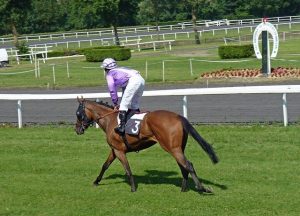 Chester racecourse is a horseracing track located in Chester, Cheshire, England. It is famously known as the Rodee. The racecourse is owned and managed by Chester Race Company Ltd. Racing there dates way back to the sixteenth century, making it one of the most ancient racing tracks in England. Despite its small size of approximately 1.8 km in length, Chester attracts a tremendous crowd of about 250,000 people in the 15-event season that runs from
Chester racecourse is a horseracing track located in Chester, Cheshire, England. It is famously known as the Rodee. The racecourse is owned and managed by Chester Race Company Ltd. Racing there dates way back to the sixteenth century, making it one of the most ancient racing tracks in England. Despite its small size of approximately 1.8 km in length, Chester attracts a tremendous crowd of about 250,000 people in the 15-event season that runs from
May to September. The races held there are strictly flat races. It is seated on a 65-acre piece of land on the banks of River Dee, making it a beautiful venue to watch the races from.
It is said that the ancient Romans established Chester as an anchorage point where they could access the Irish Sea from. This made it a busy trading port, and was later left abandoned as a public land after silt had covered it. Years later, it became a home for the Goteddsday football match, which was banned in 1533 for its violent nature. Horse racing was then introduced in 1539, and the first race was recorded in February of the same year. Since then, races have been taking place every year at Chester racecourse. In 2008, a restaurant was opened up in the racecourse named “1539”. This marked the year in which the first race took place there.
The most notable races held in the racetrack are the Chester Cup and the Cheshire Oaks. The Chester Cup is a handicap race, and was first run in the year 1824. It is run over a distance of 3,746km, and is only open to horses aged four years and above. Cheshire Oaks on the other hand was inaugurated in 1950. It takes place every May, and is open to horses aged three years. The race is run over a distance of 2,281 meters.

 Pontefract racecourse is a horse racing track located in Pontefract, Yorkshire, England. It is owned and managed by the Pontefract Park Race Company Ltd. The course is left- handed, and is about 5km long, with the last three furlongs steeping up a hill, making the finish very challenging. The course hosts flat races, and is considered as the largest flat racing track in the whole of Europe. It is easily accessible by public transportation, making it convenient to most racegoers. By train, one can choose to either use the Glasshoughton orTanshelf station. Bus services are also available and run frequently from Pontefract to Castleford.
Pontefract racecourse is a horse racing track located in Pontefract, Yorkshire, England. It is owned and managed by the Pontefract Park Race Company Ltd. The course is left- handed, and is about 5km long, with the last three furlongs steeping up a hill, making the finish very challenging. The course hosts flat races, and is considered as the largest flat racing track in the whole of Europe. It is easily accessible by public transportation, making it convenient to most racegoers. By train, one can choose to either use the Glasshoughton orTanshelf station. Bus services are also available and run frequently from Pontefract to Castleford. The Berkshire Novices’ Chase is a Grade 2 novices’ steeplechase run over 2 miles, 3 furlongs and 187 yards at Newbury in late November or early December. Open to horses aged four years and upwards, the race was inaugurated, as the Hopeful Chase, in 1987. It was renamed in 1991, to commemorate celebrated National Hunt trainer Fulke Walwyn – who died at his home in Lambourn, aged 80, in February that year – and again, to its current title, in 2006. That said, the Berkshire Novices’ Chase has been run under various titles for sponshorship purposes, including the Fuller’s London Pride Novices’ Chase and the Ladbrokes Novices’ Chase.
The Berkshire Novices’ Chase is a Grade 2 novices’ steeplechase run over 2 miles, 3 furlongs and 187 yards at Newbury in late November or early December. Open to horses aged four years and upwards, the race was inaugurated, as the Hopeful Chase, in 1987. It was renamed in 1991, to commemorate celebrated National Hunt trainer Fulke Walwyn – who died at his home in Lambourn, aged 80, in February that year – and again, to its current title, in 2006. That said, the Berkshire Novices’ Chase has been run under various titles for sponshorship purposes, including the Fuller’s London Pride Novices’ Chase and the Ladbrokes Novices’ Chase.